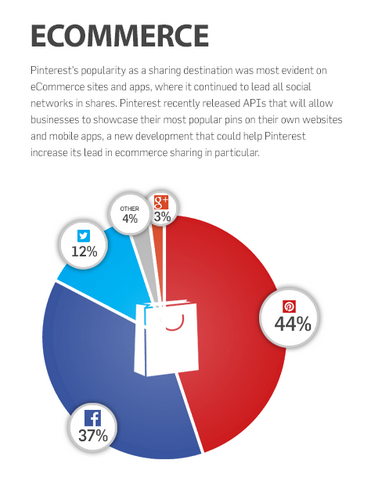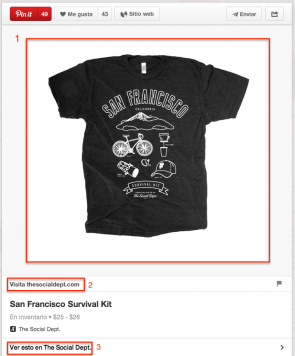Written by Fani Sánchez
Index
Rich p ins are the Pinterest platform’s latest approach to e-commerce. Over the past few months, Pinterest has identified the needs of part of its target audience and has evolved into a tool for brands that want a showcase for their products and services.
First, the Pinterest for Business division was created, which integrated exclusive features for brand and business profiles that had confirmed they were through profile verification. And later, it integrated its own analytics tool, learning from the experience of other platforms such as Facebook or Twitter, which demonstrated that this functionality brings added value to the user.
Types of rich pins
Pinterest has relied on the most shared content on the platform to establish various types of rich pins that can encompass them all. These are the different types of rich pins that you can use on your site:
Place-enriched pins
We recently told you how to take advantage of place pins in this article. In the most complete cases, they include map, telephone and address. By sharpening your wits, you can combine this enriched pin with others. For example, in this pin, Etsy shows us a photograph of the streets of Venice. The item for sale (the photograph), is marked with the product pin and shows its price, and below, with a place pin, we can see the map with the approximate location where the photograph was taken.
Enriched recipe pins
If there’s anyone that competes with Instagram in the amount of food images and recipes uploaded, it’s Pinterest. With these enriched pins you can stipulate the ingredients, cooking or refrigeration time and all the details that anyone interested in putting their culinary skills into practice would need to know.
Enriched film pins
These pins contain information about the title, release date, director and stars, and finally a rating or score. It is widely used in blog profiles related to film and television, as well as by production companies, distributors or movie theaters.
Enriched pins for articles
It is a preview on an article very similar to the one offered by Facebook or Twitter. Includes information about the headline, the author and a brief description. It is used by portals such as the Washington Post or Mashable.
Enriched product pins
This is the cornerstone of rich pins for any brand or online store. Product pins include information about the price of the product, the brand or store that sells it and whether it is currently in stock (availability). You can even specify details such as product color, geographic availability or the date on which the product will no longer be available for sale.
And according to recent studies, priced pins generate up to 36% higher conversion rates.
Rich Pins for your online store
In a previous article, we explained the advantages of having a Pinterest profile for companies. Local businesses, online stores or big brands have signed up to have a presence in this multitudinous meeting point where aesthetics and visuals predominate.
Pinterest users spent $160 per purchase, compared to $70 spent by Facebook or Twitter shoppers.
Pinterest is the third social network where most content is shared, with a 20% share and only behind Facebook and Twitter. It also generates more traffic to e-commerce than Twitter and it is estimated that its users are 10% more likely to buy than those coming from other networks.
59% of Pinterest users say they have purchased a product that they had previously seen on this social network.
Obviously, the vast majority of these studies collect data at a global level or from samples collected in the United States, where e-commerce is also much more developed. But sooner rather than later, these trends tend to be replicated in Spain. Do you need more data to start using this platform in as many ways as possible? You can consult the study prepared by Gigya by clicking on the graph below.

Using rich pins on your website, gives the traditional pin one more link from which the audience can reach your website and in particular, the rich pins for product add details of great interest about it, without the need to enter our website. This is a quality that far from taking away referral traffic, can be the differential factor that attracts the undecided visitor and potential customer.

If the user has liked your product (for more than just repinning it on his dashboard) with the rich pin he will know details that directly influence the purchase decision, such as the price of the item or if he will have to wait too long because the product is not available. In addition, you will know instantly that it has been pinned from no blog or similar where it is more than possible that you will waste your time looking for how to purchase the item, but it comes from an online store where you can buy it instantly and where you will also find similar items of your liking.
Pinterest is the preferred social network for sharing content from online stores (44%).
How to implement rich pins in your online store
As you can see
social commerce
has been around for a while and is gaining momentum thanks to platforms like Pinterest. If you want to join this trend so as not to be left behind, here are a few instructions:
Implementation
The implementation of rich pins on your site is very similar to the implementation of Twitter Cards that we explained in another article. You can opt for several types of implementation:
- Semantic markup. It uses the standards created for the Open Graph protocol (Facebook) and the tags are included in the header of your particular product page.
- Tagged with Schema.org. It is a slightly more complex method than the previous one since you do not have to enter code only in the
<head>but also in the<body>. In addition, you must combine Open Graph and Schema.org tags. - oEmbed. The most complex form. We are talking about diving into an API, for which you will need very technical skills. Therefore, it is also the most customizable and flexible option.
If you want more detailed information for developers and intrepid people, visit this Pinterest help page.
- Plugins for WordPress. Optionally, and for less technical profiles, there are already WordPress plugins available that integrate a solution for Rich Pins such as the latest update of NextGEN Facebook Open Graph+ or ABG Rich Pins. If you have an online store set up in WordPress with WooCommerce the first plugin could be an option.
Validation of enriched pins
The next and final step is to check the validity of our enriched pins with Pinterest’s tool. To do this, just as we did when validating Twitter Cards, we enter the URL in the rich pins validator. In theory, you only need to validate one URL for each type of rich pin you have on your website. I.e. a product URL to validate all the product rich pins of your online store, a URL of a post of your blog to validate the article rich pins of all the posts of your blog, etc. How long it takes to validate the rich pins is not known, but we assume that it should not take more than a couple of days.